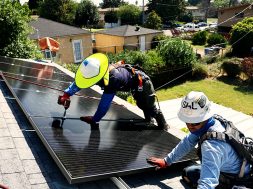
Bengaluru’s first 3-D map to harness solar energy
Bengaluru: For the first time in the country, researchers deployed an advanced Light Detection and Ranging (LiDAR) system on a helicopter to draw up a 3D map of Bengaluru city, to assess the potential for harnessing solar energy over each building, and provide civic agencies the data for better planning of all amenities in the state capital.
The study, carried out by researchers at the Centre for Study of Science, Technology and Policy (CSTEP), Bengaluru, ended on Tuesday with sorties flown over 1000 square km, sans 100 square km of defence establishments and installations.
This high-resolution map of the city would help researchers estimate the shadow-free area atop each building, provide the details to owners and help them pick the best spot for installation of rooftop photovoltaic (RTPV) sets, and help BESCOM achieve the target of one Gega watt power from such sets in a couple of years. The aerial survey was carried out in collaboration with Geokno Pvt Ltd, and funded by MacArthur Foundation. CSTEP will be able to figure out all rooftops suitable for RTPV installations in BESCOM area.
“By working closely with BESCOM and mapping their distribution transformer network using GIS, we will shortlist suitable rooftops based on available capacity in each of the connected distribution transformers. Further ranking of rooftops will be carried out based on the financial outlay of BESCOM,” Saptak Ghosh, project leader and research scientist at CSTEP, told Deccan Chronicle.
He said the database would be available for owners within three months to help them identify their buildings. Besides, CSTEP will also develop an app/web-based tool to help owners access their rooftops and draw a polygon indicating their preference for choosing the area for installation of RTPV sets. Based on this input, the tool will provide an accurate RTPV system design along with the projected business case so that each owner could make a decision on investment in these systems.
Commenting on the unique study, Mr P Ravi Kumar, additional chief secretary (energy), government of Karnataka, said the data would also be made available to civic agencies to help them plan all types of amenities, to estimate the tree cover in Bengaluru, or better management of traffic, and reduction of flooding of roads and pathways. “We will use this technology in Tier-II cities once the efficacy of this new technology is established in Bengaluru,” he added.
Mr Ghosh said large-scale replication of such efforts across all metros, and tier I and tier II cities would cost about Rs 200 crores, much lower than the governments spend on one large ground-mounted solar park. “With scientific assessment studies and policy shifts to innovative aggregator models, RTPV might just get the boost it needs and the national target of 40 GW by 2021-22 will not seem so ambitious or challenging anymore,” he added.















